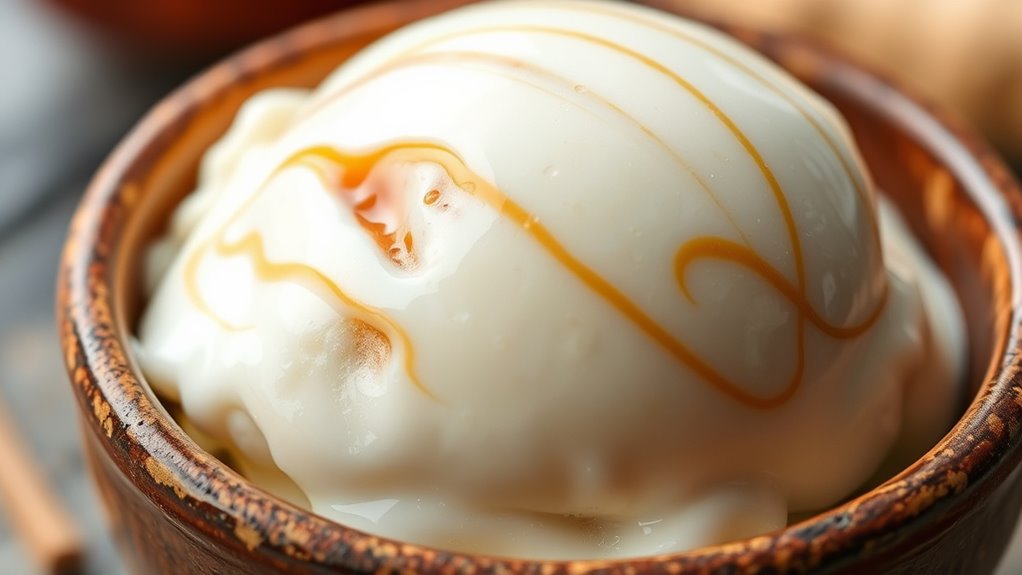Milk is the foundation of gelato, directly influencing its texture, flavor, and overall quality. High-quality milk makes your gelato creamy, smooth, and full of nuanced flavors. Seasonal variations, like summer grass-fed or winter feed, add unique tastes and richness. The fat and proteins in milk help create that luscious, velvety mouthfeel you crave. To discover how to choose the best milk for premium gelato, keep exploring what makes this ingredient so essential.
Key Takeaways
- Milk constitutes 70-80% of gelato, shaping its texture, flavor, and overall appeal.
- High-quality milk enhances gelato’s creaminess, smoothness, and nuanced flavor profiles.
- Fat and proteins in milk act as emulsifiers and flavor carriers, improving mouthfeel and taste.
- Seasonal and sourcing variations influence milk’s flavor, adding authenticity and unique characteristics.
- The quality of milk is essential for achieving luxurious, satisfying gelato with a velvety texture.

Have you ever wondered what makes gelato so irresistibly creamy and flavorful? The secret lies largely in its primary ingredient: milk. Typically, about 70-80% of gelato’s composition is milk, which plays a pivotal role in shaping its texture, flavor, and overall appeal. When you savor a scoop, you’re experiencing the result of high-quality milk that contributes to a rich, smooth mouthfeel and a balanced creaminess that sets gelato apart from other frozen desserts.
Gelato’s creamy perfection comes from 70-80% high-quality milk, shaping its rich flavor and smooth texture.
The quality of this milk directly impacts the final product—better milk means a more nuanced flavor, a velvety texture, and a luscious creaminess that melts seamlessly on your tongue. Using high-quality milk isn’t just about taste; it also influences the gelato’s texture and mouthfeel. Milk with well-balanced fat and protein content enhances the smoothness, giving the gelato a luxuriously soft consistency that makes each spoonful delightful.
The fat in the milk acts as a natural emulsifier, helping to develop that silky, luscious texture you crave. Additionally, the proteins in the milk release flavor more effectively, intensifying the overall taste experience. When the milk is sourced from farms that prioritize cow health and land stewardship, the resulting gelato benefits from a purer, richer flavor profile, elevating your enjoyment.
Locally sourced, ethically produced milk often yields more complex and vibrant flavors, thanks to careful animal care and sustainable farming practices. Seasonal variation also plays a part in the character of the milk used in gelato. Milk produced in summer, with cows grazing on lush, green pastures, tends to be creamier and richer, imparting a fuller, more indulgent flavor.
Conversely, winter milk, influenced by colder climates and different diets, can have a more herbal or subtle note, adding a unique seasonal variation to the gelato’s flavor profile. This natural fluctuation enriches each batch, making your gelato experience slightly different depending on the time of year. It’s this seasonal variation that offers a dynamic and authentic touch, making each scoop a reflection of nature’s influence.
In essence, milk isn’t just an ingredient; it’s the foundation of gelato’s signature smoothness, flavor, and creaminess. Milk quality and careful sourcing play crucial roles in delivering the optimal taste and texture, ensuring that every bite is indulgent and satisfying. High-quality milk, carefully sourced and seasonally influenced, guarantees that every bite delivers a perfect balance of richness, texture, and flavor. That’s what makes gelato truly special—its ability to combine simple ingredients into a luxurious, unforgettable treat.
Frequently Asked Questions
Do You Use Milk in Gelato?
Yes, you use milk in gelato because it’s essential for creating its smooth, creamy texture and rich flavor. The milk you choose, especially from local, ethically farmed dairies, adds depth and freshness.
You’ll notice that using high-quality, pasture-grazed milk results in a lighter, more delicate product. Since gelato uses less cream and milk than ice cream, your choice of milk truly influences the overall taste and quality.
What Is the Function of Milk in Ice Cream?
You ask about the function of milk in ice cream. Milk serves as the foundation, providing water, proteins, and fats that shape texture and flavor. It stabilizes the mixture, prevents ice crystal growth, and creates a smooth, creamy feel.
Its natural sugars add sweetness and influence freezing, while the fat enhances richness and mouthfeel. High-quality milk guarantees a richer, more nuanced flavor, elevating your ice cream experience.
What Makes Gelato so Creamy?
You notice gelato’s incredible creaminess because of its lower fat content, which allows flavors to shine and creates a smoother texture.
The slow churning process incorporates less air, making it denser and velvety.
Serving it slightly warmer releases more fats and flavors, enhancing richness.
High-quality milk provides small fat globules and nuanced flavors, all working together to give you that irresistibly creamy, luxurious mouthfeel you love.
What Is Gelato Without Milk Called?
Think of gelato without milk as a invigorating, fruity air—it’s called a sorbet. You’d notice its lighter, more revitalizing texture and intense fruit flavors.
Unlike traditional gelato, it skips the dairy, relying solely on water, sugar, and fruit purée. Perfect for vegans or those with lactose intolerance, sorbet offers a vibrant, dairy-free treat that’s just as satisfying without the creamy richness.
Conclusion
So, next time you indulge in gelato, remember that milk isn’t just an ingredient—it’s the heart and soul of that creamy magic. Without it, gelato would be as bland as a desert and as lifeless as a statue. Milk’s richness and smoothness transform simple ingredients into an irresistible masterpiece that can make your taste buds do a happy dance. Truly, milk’s role in gelato is nothing short of a culinary superhero!















